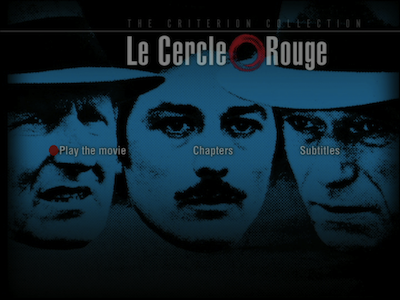
Fate plays an important role in Jean-Pierre Melville’s 1970 crime movie, Le cercle rouge. Though, I am not sure “fate” is the right word. In this hardboiled world, it’s more like the cynicism of happenstance, or an absence of faith in the human animal. Mankind will always make the wrong choice, and the wrong choice inevitably leads to only one outcome.
There are two storylines that form Melville’s red circle. One involves an escaped convict and the policeman he got away from. Vogel (Gian Maria Volonté) was being transported by train to his trial. His escort was Captain Mattei (André Bourvil), an older, no-nonsense police detective. When Vogel slips his shackles and jumps from the train, Mattei starts a manhunt that will last the length of the picture. He must bring the crook back in order to save face.

At the same time, another thief is being released from prison. Corey, played by French matinee idol and Melville regular Alain Delon, has his jail sentence cut short on the promise that he will pull a jewel heist for the guard arranging his release. The guard has inside info on the security system at a jewelry shop, and his cut when Corey cleans the place out will allow him to retire. Corey doesn’t really want the gig, he doesn’t want to get out of the clink to go right back in, but what choice does he have? Not that much is waiting for Corey on the outside. His girl has left him for Rico (André Ekyan), the gangster who betrayed him when he was sent up the river. Corey’s first order of business is getting some walking-around money from Rico; it’s also his first mistake.
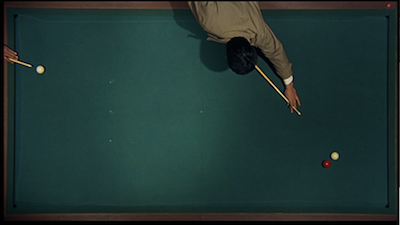
Once both Vogel and Corey are on their path, circumstances immediately go into motion to bring them together. Cleverly, Melville creates a literal circle around the two men, one that will close in around them. Mattei traces the ring on a map, indicating the locations of the road blocks meant to capture Vogel. They fail, and Vogel becomes Corey’s partner in the jewel heist. He also brings in the third man, an ex-cop by the name of Jansen (legendary French actor Yves Montand). Though a drunk with the DTs, Jansen is an ace marksman, which the guys will need. He’s also a security expert, and so he cases out the target to make sure the intel is correct.
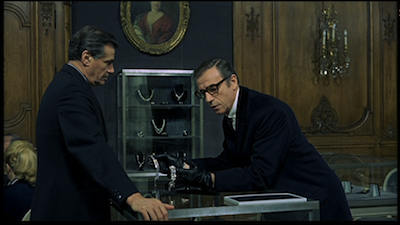
Le cercle rouge is famous for its 25-minute heist sequence, in which no dialogue is spoken. It immediately brings to mind the similar silent robbery in Jules Dassin’s Rififi [review], though reportedly Melville was planning his rip-off several years prior to the Dassin picture and actually postponed Le cercle rouge as a result. Though much is made of the quietness of this astounding section of film, the entire picture has a resounding silence throughout. Little is said in Le cercle rouge, there are no wasted words. These are men who all have a job to do, regardless of what side of the law they are on, and they will do it with a kind of religious devotion. Activity replaces spirituality in Melville’s world. Occupation is more important than vocation. The appropriation of Oriental philosophy for this kind of existential code of conduct is similar to Melville’s portrayal of the stoic gun thug in Le samourai. He, too, was played by Delon, and both films share lookalike nightclub settings.
The nightclub here is owned by Santi (François Périer), a stand-up guy and a friend of Vogel. Mattei is convinced Santi will be the key to finding the fugitive, but the club owner has the most clear statement of existential intent in the film when he insists that he cannot inform on his friend and never can be persuaded to do so because, fundamentally and deep down, he is not an informer, it is not his nature, simple as that. Mattei will challenge this self-perception and offer Santi a difficult choice, one that will violate his code and force him to weigh the consequences of not doing so. It’s an ethical conundrum worthy of Sartre, and the policeman is employing his own harsh philosophy: “All men are guilty. They're born innocent, but it doesn't last.” There is only one possible outcome to all of this as far as Mattei is concerned; after all, he is the one drawing the circle. Other visual metaphors reinforce the sameness in all beings, from the prevalence of beige raincoats to the dance routines at Santi’s club, featuring a troupe of gals all dressed alike, all moving alike, all exactly the same.
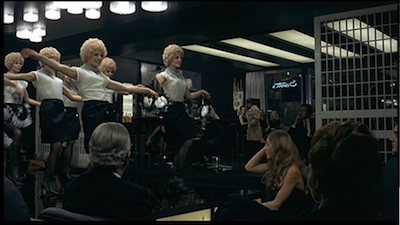
Le cercle rouge is shot with a meticulous rigor by Henri Decaë, and then edited with precision by Marie-Sophie Dubus, with Melville sitting by her side. The movie is pieced together with a clear attention to detail and an obvious devotion to narrative integrity. Melville employs few tricks, but the ones he does use add an efficiency to what is technically a long movie--though one that never shows its length. Zooming in on key points around the jewelry store, the fades in the montage when Jansen makes his bullets (almost like flipping pages in a book), or the choppy hallucinations when the marksman is drying out all enhance the corresponding activity without overdoing it. There are also nice touches in the art direction, such as Jansen’s vertically lined wallpaper and the doorway that disappears into the pattern, that add to the mood without overpowering their specific scenes. I’m also quite found of the subtle character details given to Mattei: the framed photos of an absent wife and the apartment full of Siamese cats suggest a man who is lonely, and yet at peace.
Melville prefers long takes to quick cuts, particularly as the robbery is planned and executed. We witness each step, each careful action. Most of the time, he is content to sit and watch, but there is also plenty of camera movement. Actually, one of Le cercle rouge’s first shots is an astonishing pull back from Mattei and Vogel’s train window, starting on the police detective as viewed through the glass, and then soaring off into the air, the window becoming smaller in the distance, the length of the train becoming more evident. It’s almost as if Melville intended to show how tiny the individual person is within the world, just one small passenger on the journey of life, subject to wherever that journey will take him or her.
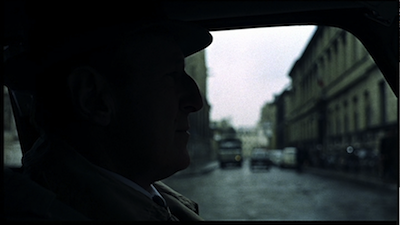
It’s also a scene that looks phenomenal on Blu-Ray. Image quality is of utmost importance in a film like this, where so much relies on the audience seeing every minute detail clearly. Many of the scenes take place in darkness, and even in the daytime the skies are gray and cloudy, but the picture is rendered well enough that everything is visible, even within the intended shadows. The film stock has a lovely grain to it, adding to the grittiness of the montage. I originally saw Le cercle rouge seven years ago on a theatrical tour, and it only impresses me more each time I see it in a new, updated format. The new edition mirrors and carries over all the extras from the old edition, but cinema obsessive’s will still want it for the improved picture and sound.
Then again, La cercle rouge would continue to impress even without new technological innovations. It is a movie where the barebones construction and near-monastic avoidance of excess masks its hidden depths. The further you peer into it, the more gears you see turning in the background. It takes a lot of complicated work for a movie to appear this clear-cut, and when it comes to the mechanics of motion pictures, Jean-Pierre Melville was a master.
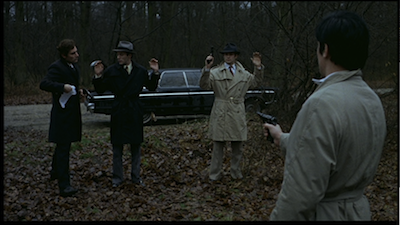
This disc was provided by the Criterion Collection for purposes of review.
Screen captures are from the DVD, not the Blu-Ray.

No comments:
Post a Comment